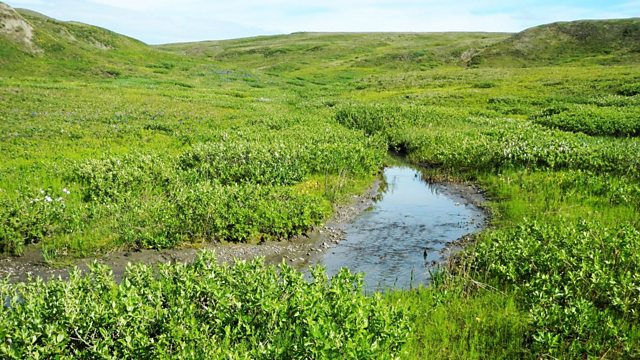Global Warming and the Arctic Tundra
Global warming and the Arctic tundra; Storing ice cores in the Antarctic; Floods in China caused by pollution; Separating the medicinal effects of cannabis.
The climate is warming faster at the Poles, and this could be altering the important tundra landscape that circles the Arctic, according to a group of scientists studying this important biome. Historically the short summers and cold winters meant that the tundra regions were too cold for trees to grow tall, leaving a landscape dominated by grasses, flowering plants and low shrubs. But recent warming has led to the shrubs getting taller, and more dense in some parts. And taller shrubs means that the snow does not lay in a smooth blanket, losing the insulating effect in winter and reducing the amount of sunlight reflected back out to space. Together with changes in the soil chemistry, which could lead to greater releases of greenhouse gases, like carbon dioxide and methane, this could set up an irreversible feedback loop leading to increased global temperatures.
Ice Cores
Ice core samples have been invaluable in helping us to learn about past climates. By measuring the atmospheric gases trapped in the deep layers of ice, drilled in long sections from the permafrost, can help scientists to understand historic atmospheric conditions on Earth. But keeping these valuable time capsules in pristine conditions can be tricky. What if the freezer they are kept in breaks? One idea is to take them back to the Antarctic and store them in ice caves.
China's Flooding Linked to Pollution
In 2013 Sichuan in Central China suffered some terrifically powerful storms and subsequent flooding. An estimated 3.5 million people were affected, buildings collapsed and agricultural land was ruined. You may think this is a result of the more turbulent weather caused by climate change. But this time pollution, soot particles from big industrial areas, is thought to be to blame.
Solar Impulse
Solar Impulse, the solar powered aeroplane has successfully crossed the Pacific. It took 100 hours to cross the 7200 km. The next leg is across the USA to New York before it attempts to cross the Atlantic.
Pluto
NASA's New Horizons probe is approaching the dwarf planet Pluto. After some technical glitches the team hope to get some really good data from a close look at the recently demoted planet and its moons.
Medicinal Cannabis
An increase in the medical use of cannabis has led to it becoming legal in 23 of the United States. People take the narcotic herb for pain relief, epilepsy, and as an anti-spasmodic for Multiple Sclerosis sufferers. But the side effects on memory and the risk of psychosis, especially in younger users, still remains an issue. Now researchers have separated the 'medical' from the 'narcotic' pathways in the brains of mice, and from this, they hope to develop a safe medical form of marijuana.
Photo caption: Tundra on Qikiqtaruk-Herschel Island on the Arctic coast of the Yukon Territory 漏 Isla Myers-Smith/PA Wire
Presenter: Jack Stewart
Producer: Fiona Roberts
Last on
More episodes
Previous
Clip
-
![]()
Can a bushier tundra change the climate?
Duration: 01:50
Broadcasts
- Thu 9 Jul 2015 18:32GMT大象传媒 World Service Online
- Thu 9 Jul 2015 23:32GMT大象传媒 World Service Online
- Fri 10 Jul 2015 04:32GMT大象传媒 World Service Online
- Fri 10 Jul 2015 12:32GMT大象传媒 World Service Online
- Fri 10 Jul 2015 15:32GMT大象传媒 World Service Online
Podcast
-
![]()
Science In Action
The 大象传媒 brings you all the week's science news.



